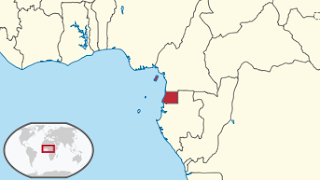Where is Equatorial Guinea one might ask? I know my first thought was I was going to the south Pacific. Alas, I was thinking of Papua New Guinea. In fact there are five (or six if you count Guyana which is derived from Guinea) counties in the world with "Guinea" as part of their name, of which three are found in West Africa. So my confusion over where I was being sent was understandable. I am still excited about the job opportunity even if I was a little disappointed it wasn't Papua New Guinea.
 |
| Equatorial Guinea is the small country in red. |
 |
| Flag of Equatorial Guinea |
Equatorial Guinea's official name is the Republic of Equatorial Guinea. It is about 111,000 square miles which is about the size of Massachusetts and has population of 730k which is slightly larger than the city of Boston. EG gained its independence from Spain in 1968. So the national language is Spanish (just my luck, spent years avoiding learning Spanish and now being semi-fluent would be useful). Officially EG is a unitary semi-presidential republic. Basically this is a fancy way of saying that EG is controlled by a single entity who is "elected" by the people.
EG is made of a mainland
territory, Rio Muni, and five small islands located in the Gulf of Guinea.
Despite its name EG is not located on the equator, it lies almost
entirely above the equator. The exception
of this is a small island of Annobon which is located in the southern
hemisphere. I will be living and working on the largest of these islands,
Bioko. The capital of EG, Malabo, is
located on this island as well as most of the oil industry. EG has several ecoregions such a Atlantic
Equatorial costal forests, Central African mangroves, Cross-Sanaga-Bioko coastal
forests, Mount Cameroon and Bioko
montane forests, and Sao Tome, Principe, and Annobon moist lowland forests (I
will talk more about these regions in another post). Given EG’s tropical location it’s no surprise
that it has a tropical climate and only has two seasons, wet and dry. From June to August, Bioko is wet and Rio
Muni is dry and from December to February it is reversed. From September to November and from March to
May there is a gradual transition from on season to the next.
0 comments:
Post a Comment